Critically identifying issues and opportunities in the e-commerce sector
CRITICALLY IDENTIFYING ISSUES AND OPPORTUNITIES IN THE E-COMMERCE SECTOR OF INDIA: A CONTRASTING STUDY WITH UK
Introduction:
The suitable style of E-business model can be achieved by intangible materials like mobile phones, computers. The internet usage can be done by PNSP (path 2) (Aithal, P.S., 2015).
Justification
As the market trend in E-Commerce is increasing on daily basis it gives an opportunity to study trends and possible opportunities in the field of E-Business. Therefore this research gives an opportunity to study the opportunity which is lying in E-Business sector. In India this sector has shown a rapid growth in past few years and in UK also this sector has shown tremendous growth which makes it much more evident that this type of studies should get conducted so that technological and management glitches related to this new emerging field can be solved.
Literature Review
India E- Business
E-Business is increasing and the stature of this growth can be presumed by reports that are published in different sources. In India according to a report published by KPMG it is a professional service company and one of the four biggest auditors around the world today. Its current market value is about USD 19.5 billion and all these values are computed before any returns and rejection of the product that has taken place. It is almost estimated that Indian E-Business market has got a potential of about 80-100 million online shoppers. To cater to this huge market segment there is a requirement of providing new opportunities to this emerging business sector. If we talk about market segmentation then it can be said that baby and personal care sector is the major occupant for E-Business sector in India. India is a diverse country with diverse population content and their requirements are also diverse. Keeping all these things in mind E-Commerce is becoming a platform of getting products that are not available easily in physical stores of any particular region (assets.kpmg.com, 2018).
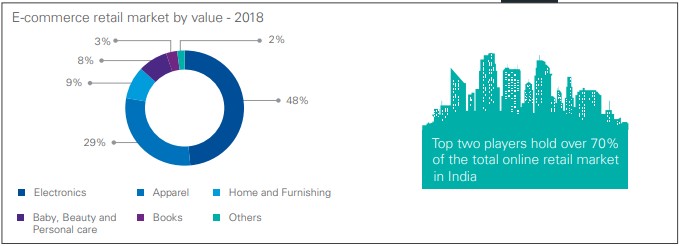
Figure 1: E-Commerce retail market value of India
(Source: assets.kpmg.com, 2018)
E-Business provides customers to shop from their suitable location and also gives opportunity to compare any given product with similar types of products that are available on any particular shopping portal. In present scenario E-retailers are also indulging into a competition for providing best and competitive pricing to its customers so that they can attract more customers.
Along with it there is a new trend of releasing a new product at E-Commerce platform and giving offers to attract customers. For growth in this sector there are many factors which can influence the scenario in India. Like internet penetration, language diversification of E- Business platform, influence of social commerce, convenience of use of technology, availability of E- wallets all these points fuels up the growth of e-business in India.
Supply chain is an important sector for growth of E-Business sector in any country, proving in time shipment is a requisite for this sector. In India also there is a increase in the retail logistic segment for E-Business. Currently more than 60% demand comes from metro tier-1 cities. However it is expected that there will be a slowdown in the demand segmentation in the tier one cities of India. Rather tier two cities will emerge as new business destination for the E-Business sector in coming years.
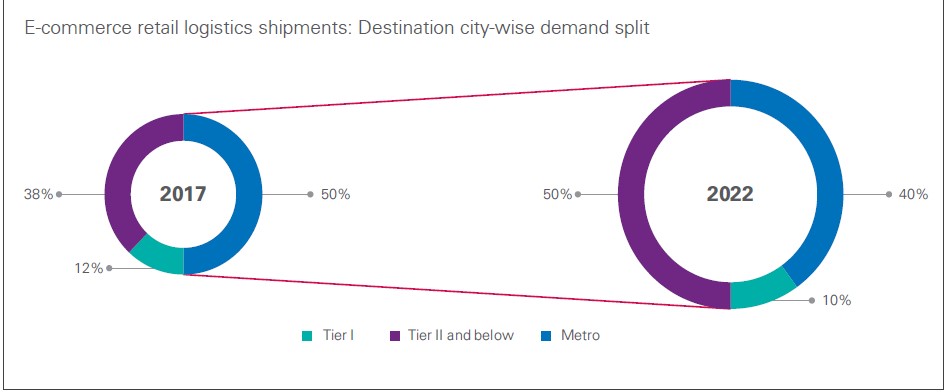
Figure 2: Expected shift in demand centre
(Source: assets.kpmg.com, 2018)
There is shift in product categories also that are required and with that there is a change in the shipment pattern also. In today&apso;s scenario in India it can be seen that there is a increase in large size and fragile shipments like furniture and electronic goods for example television. Products which are large in size and fragile are required to be shipped with special shipment categories and E-Business platforms are trying to develop this type of infrastructure so that they can serve the customers in better way.
Cost of Technology
Main requirement for E-Business is technology without technology it is impossible for E-Business sector to improve its present presence in India. In a case study of Malaysian E-Business sector it was found that there are two things that are important to enhance the E-business sectors technology demand. Technology acceptance model (TAM) (Davis, 1989) and Diffusion of innovation (DOI) (Rogers, 1995) are two important points that are required to increase technological advances (Kurnia, 2015). DOI is a process through which there is an adaptation of innovation for gathering information and reducing uncertainty that are there with usage of technology. For TAM it is usage segmentation of technology, it can be said that ease of usage and usefulness of that technology are important for any technology to get accepted. From the point of view of India it is very important that technology enhancement should happen faster. If technology enhancement becomes faster than inclusion of tier three and tier four cities will increase in the E-Business sector of India.
If we are talking about technology it always does not means software technology means use of technicality in easing different aspect of work. For E-Business internet usage and providing good software platform is important. However there are many other aspects that are there like use of technology in evolving smarter logistic techniques. With the start of Digital India that is to enhance the digital capability of the country. In this program there are many internationally renowned companies that are lending their support like Intel, Nokia, Google, Facebookwho are supporting to economically to enhance digital connectivity of the country. Some Indian companies like Reliance industries ltd. has concluded that they have in principle agreed upon investing a sum of $39billion in digital space of India (Gupta and Rajesh, 2018).
On the other hand the technological cost related with E-Business is lower in UK as the reach of internet is more in UK than that is in there in India. It makes it suitable for the retailers of small time SME’s to use those technologies at the fullest for the benefit of development of their business. In UK internet reach is almost about 90% of the total household that is present there in G.B.R. Adults who are accessing internet on the go are about 70% (ons.gov.uk, 2018). UK’s internet penetration is higher than that of India. It was found that 481 millions of Indian citizens use internet and is expected to hit about 500 million users in about one year time (assets.kpmg.com, 2018).
Risk of E-Business
E-Business related risks are mainly based on scenario and decision analysis and are termed as E-commerce risk management (ECRM). Sometimes a detailed risk analysis is required for a particular type of business but for developing strategies to content the E-Business sector from its risk factor requires an in depth resource and planning. For ECRM there are two segments that are present preliminary risk assessment and detailed risk assessment. The role of a PRS is to determine the path of Assignment and conduct meetings between higher management and systems manager so that further analysis of the risks can be implemented. In case of E-commerce PRA works on errors that has occurred due to some omission or structural weaknesses of the organisation or any type of weakness. In detailed risk management project team considering PRA and members at different levels of organization makes and develops detailed based scenarios. Those scenarios are implemented to see that any type of drastic risk factors is arising from that or not. So, with doing a brainstorming between them the risk scenario are discussed along with that possible way outs are also talked.
Risk related to SMEs sometimes is also holds firm adjective towards E-Business. What amount of money to invest how to build up value chain? Experience in the field of IT as is also an important factor that plays a factor in risk mitigation in E-Commerce business [Grant, Edgar, Sukumar and Meyer, 2014]. These risks factors are vital for a businessman to sum it up and mitigate these factors to do their business with ease. To mitigate the risks in business there are few points that a businessman should always keep in mind. Insuring the business and selecting right type of business. Along with it networking and cooperative bonding with others and providing security to the system [Falkner and Hiebl, 2015]. These are the points that are essentially required to improve the risk assessment situation in any format of business. When the portal is E-Business then it is important that risks related to internet security are mitigated. Information system security is required to be secured in E-Business for that there can be implementation of enterprise architecture management that can be sourced in. EAM-ISSRM it provides a conceptual model for preparation of security standards of the internet segment that is important for the E-Business sector. (Mayer et al. 2018). So, in mitigating the risks involved in E-Business it is important that business holders should always be very much concerned about their network security that that are using.
Methodology
In the research that has been undertaken quantitative methodology was used for detailing of data and for its further analysis. In quantitative analysis main goal is to establish relationship between independent variables and dependent variables. In quantitative research methodology the research is either based on descriptive studies or experimental studies. In descriptive studies subject that are undertaken are studied only once, whereas in experimental studies subject undertaken are studied twice one before experiment another time after experiment. By descriptive study only relation between variables are determined where as by experimental study cause of occurrence is also determined for any variable. In quantitative analysis there are numbers, objectives, logic that are encircled with the research. In quantitative analysis data that are collected are passed through different mathematical tools or software’s that are used to calculate the convergent nature of the data. Divergent nature of the study is not present in quantitative analysis. So, it becomes important that data collected are in numeric format for research that are conducted under quantitative analysis. Data collected for this type of research are through structured research instruments that are applicable for this research also. Larger sample sizes are required for this type of research so that representation of population is defined properly.
Researcher prepares a properly defined research question that is to be analysed with data which has been collected through different procedures that are required for research to take place. Data collected should be represented in the form of numbers, figures and not in textual format that cannot be interpreted via any mathematical tool. In this research also there are data that are collected via different procedures and are analyzed by SPSS software.
Results and Discussion
Internet Usage
The hypothesis for this topic was prepared and that was reviewed by T test by SPSS software that was conducted. Hypothesis were as follows
H1 - Availability of internet between UK and India has statistically significant difference.
H2 - Availability of internet between UK and India do not have statistically significant difference.
|
Paired Samples Statistics | |||||
|
Mean |
N |
Std. Deviation |
Std. Error Mean | ||
|
Pair 1 |
Usage_Internet_India |
1.23 |
13 |
.439 |
.122 |
|
Usage_Internet_UK |
2.23 |
13 |
.927 |
.257 | |
|
Paired Samples Correlations | ||||
|
N |
Correlation |
Sig. | ||
|
Pair 1 |
Usage_Internet_India & Usage_Internet_UK |
13 |
.678 |
.011 |
|
Paired Samples Test | |||||||||
|
Paired Differences |
t |
df |
Sig. (2-tailed) | ||||||
|
Mean |
Std. Deviation |
Std. Error Mean |
95% Confidence Interval of the Difference | ||||||
|
Lower |
Upper | ||||||||
|
Pair 1 |
Usage_Internet_India - Usage_Internet_UK |
-1.000 |
.707 |
.196 |
-1.427 |
-.573 |
-5.099 |
12 |
.000 |
When samples of the first case are considered the correlation between internet usages of India and internet usage of UK is 0.678 which means that there will be no pairing between the two data sets it is insignificant. The T value has come -5.099, which means that the difference between two variables is there that is in the negative direction.
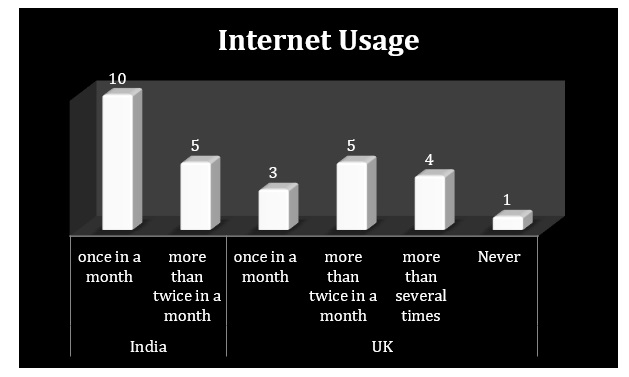
Figure 3: Internet Usage
Purpose of Usage
H3: Internet usage purpose has statistically significant difference between India and UK.
H4: Internet usage purpose does not have statistically significant difference between India and UK
|
Paired Samples Statistics | |||||
|
Mean |
N |
Std. Deviation |
Std. Error Mean | ||
|
Pair 1 |
Purpose_of_Usage_India |
3.08 |
13 |
.954 |
.265 |
|
Purpose_of_Usage_UK |
3.46 |
13 |
1.506 |
.418 | |
|
Paired Samples Correlations | ||||
|
N |
Correlation |
Sig. | ||
|
Pair 1 |
Purpose_of_Usage_India & Purpose_of_Usage_UK |
13 |
.901 |
.000 |
|
Paired Samples Test | |||||||||
|
Paired Differences |
t |
df |
Sig. (2-tailed) | ||||||
|
Mean |
Std. Deviation |
Std. Error Mean |
95% Confidence Interval of the Difference | ||||||
|
Lower |
Upper | ||||||||
|
Pair 1 |
Purpose_of_Usage_India - Purpose_of_Usage_UK |
-.385 |
.768 |
.213 |
-.849 |
.079 |
-1.806 |
12 |
.096 |
In this segment of result the T test and correlation between purposes of usage of internet was done and a result and outcome that came was correlation 0.901 and the T test value is -1.806.
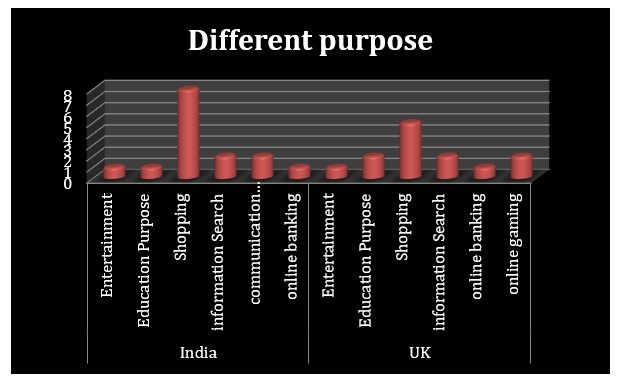
Figure 4: Purpose of usage
Method of Payment
H5: Method of payments between India and UK has statistically significant difference.
H6: Method of payments between India and UK do not have statistically significant difference.
|
Paired Samples Statistics | |||||
|
Mean |
N |
Std. Deviation |
Std. Error Mean | ||
|
Pair 1 |
Method_of_Payment_India |
1.92 |
13 |
.862 |
.239 |
|
Method_of_Payment_UK |
2.31 |
13 |
1.377 |
.382 | |
|
N |
Correlation |
Sig. | ||
|
Pair 1 |
Method_of_Payment_India & Method_of_Payment_UK |
13 |
.934 |
.000 |
|
Paired Samples Test | |||||||||
|
Paired Differences |
t |
df |
Sig. (2-tailed) | ||||||
|
Mean |
Std. Deviation |
Std. Error Mean |
95% Confidence Interval of the Difference | ||||||
|
Lower |
Upper | ||||||||
|
Pair 1 |
Method_of_Payment_India - Method_of_Payment_UK |
-.385 |
.650 |
.180 |
-.778 |
.008 |
-2.132 |
12 |
.054 |
From the table it can be seen that the correlation is 0.934 and the t-test between the paired variables is -2.132 that can be seen as a negative t result but is closer to mean of the data of either set of variables.
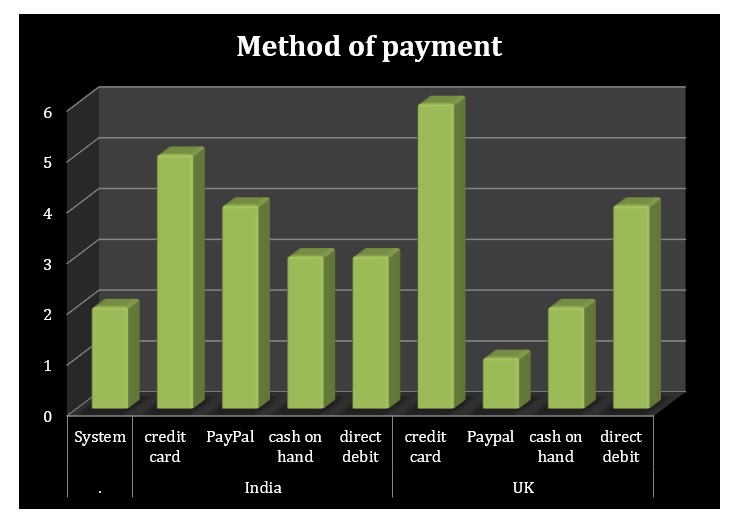
Figure 5: Mode of Payment
Satisfaction of Customers
H7: Customer satisfaction has got statistically significant difference between India and UK.
H8: Customer satisfaction does not have statistically significant difference between India and UK.
|
Paired Samples Statistics | |||||
|
Mean |
N |
Std. Deviation |
Std. Error Mean | ||
|
Pair 1 |
Satisfaction_of_Coustomers_India |
2.31 |
13 |
.947 |
.263 |
|
Satisfaction_of_Coustomers_UK |
2.77 |
13 |
.927 |
.257 | |
|
Paired Samples Correlations | ||||
|
N |
Correlation |
Sig. | ||
|
Pair 1 |
Satisfaction_of_Coustomers_India & Satisfaction_of_Coustomers_UK |
13 |
.847 |
.000 |
|
Paired Samples Test | |||||||||
|
Paired Differences |
t |
df |
Sig. (2-tailed) | ||||||
|
Mean |
Std. Deviation |
Std. Error Mean |
95% Confidence Interval of the Difference | ||||||
|
Lower |
Upper | ||||||||
|
Pair 1 |
Satisfaction_of_Coustomers_India - Satisfaction_of_Coustomers_UK |
-.462 |
.519 |
.144 |
-.775 |
-.148 |
-3.207 |
12 |
.008 |
In the table above the correlation between the two variables was 0.847 and the T test between variables was -3.207 that show the difference between two variables that are under consideration.
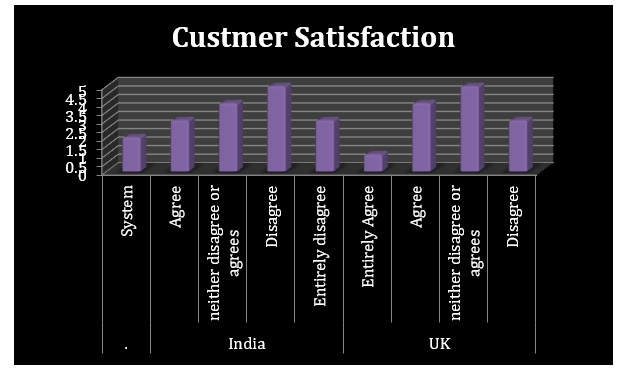
Figure 6: Customer Satisfaction
Website Convenience
H9: Website convenience has got any statistically significant difference in between India and UK.
H10: Website convenience does not have statistically significant difference in between India and UK.
|
Paired Samples Statistics | |||||
|
Mean |
N |
Std. Deviation |
Std. Error Mean | ||
|
Pair 1 |
Website_Convenience_India |
3.46 |
13 |
1.127 |
.312 |
|
Website_Convenience_UK |
3.38 |
13 |
1.193 |
.331 | |
|
Paired Samples Correlations | ||||
|
N |
Correlation |
Sig. | ||
|
Pair 1 |
Website_Convenience_India & Website_Convenience_UK |
13 |
.973 |
.000 |
|
Paired Differences |
t |
df |
Sig. (2-tailed) | ||||||
|
Mean |
Std. Deviation |
Std. Error Mean |
95% Confidence Interval of the Difference | ||||||
|
Lower |
Upper | ||||||||
|
Pair 1 |
Website_Convenience_India - Website_Convenience_UK |
.077 |
.277 |
.077 |
-.091 |
.245 |
1.000 |
12 |
.337 |
In the above table the correlation between two variables can be seen that is 0.973 and T test between the variables is 1.
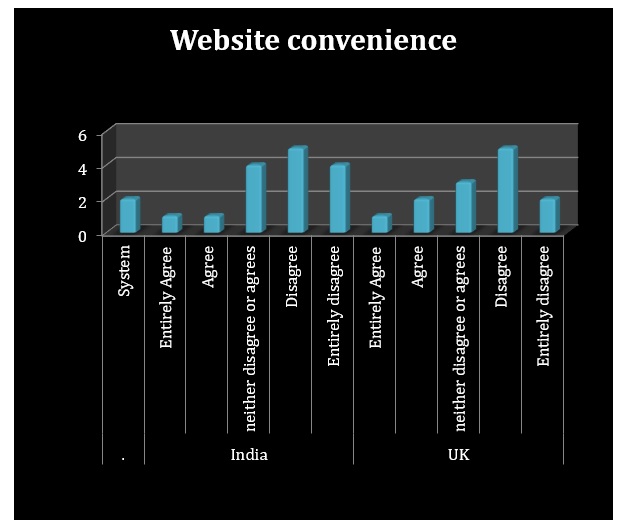
Figure 7: Website convenience
Online Shopping experience
H11: Online shopping between Indian and UK has any statistically significant difference.
H12: Online shopping between Indian and UK does not have statistically significant difference.
|
Paired Samples Statistics | |||||
|
Mean |
N |
Std. Deviation |
Std. Error Mean | ||
|
Pair 1 |
Online_Shopping_India |
2.00 |
13 |
1.000 |
.277 |
|
Online_Shopping_UK |
2.46 |
13 |
1.198 |
.332 | |
|
Paired Samples Correlations | ||||
|
N |
Correlation |
Sig. | ||
|
Pair 1 |
Online_Shopping_India & Online_Shopping_UK |
13 |
.904 |
.000 |
|
Paired Samples Test | |||||||||
|
Paired Differences |
t |
df |
Sig. (2-tailed) | ||||||
|
Mean |
Std. Deviation |
Std. Error Mean |
95% Confidence Interval of the Difference | ||||||
|
Lower |
Upper | ||||||||
|
Pair 1 |
Online_Shopping_India - Online_Shopping_UK |
-.462 |
.519 |
.144 |
-.775 |
-.148 |
-3.207 |
12 |
.008 |
In the above table the relation between the variables are seen its correlation is 0.904 and T test value is -3.207. It gives a clear indication of the results that are retrieved from data that has been collected. All this result has been analyzed against the research aim that was selected by researcher.
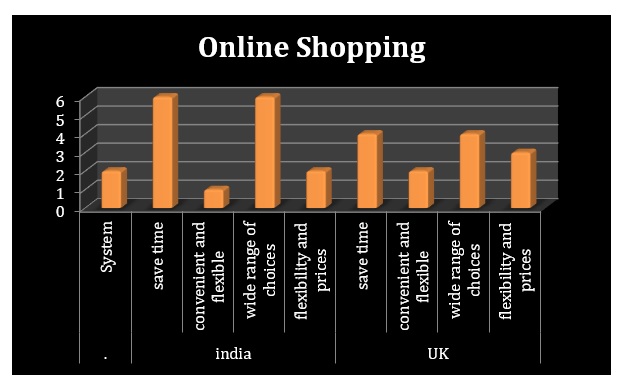
Figure 8: Online shopping
Data analysis
In this segment data that was collected and calculation that were done will be analysed and will be compared to research aim for this particular research topic. In the first part we can see that hypothesis H2 is more relevant because T-test shows that there is a difference in the between the availability of internet service in India and UK. Correlation between two topics are insignificant as the value is greater than 0.5. In the second point the usage of internet has got little difference it shows that the internet usage is almost similar in both the countries. For the third point the method of payments also has got a lower difference that is India is also catching up slowly with UK in methods of payments. Similarly T-test for online shopping experience is little larger it shows that UK has got better online shopping experience than that of India. All these results points out that Internet facility in India is not proper and shopping experience of Indians are not good. It answers the first research question. UK is at better position than India in user experience of online shopping as the results suggest. Future is very bright as the difference of T value is less in the usage pattern section that shows Indians also use similar same amount of internet as done by people of UK.
Conclusion
In the research that was conducted to see what are the problems and opportunities that are present in the E-Business segment of India and a critical comparison that was made between India and UK. In this research it was seen that user experience of the online shopping in India and UK are not the same. Demand of products and trends of usage are almost neck to neck in India and UK. It gives a clear picture that India is gaining momentum in online shopping segment. India does not have same opportunities similar to UK but in near future with improvement in facilities it gives a better scope and chance to India to become world's largest E-Business market. This research will help others to understand the points that are a point of concern for India in becoming a good market in E-Business sector.
Reference List
Aithal, P.S., 2015. Concept of Ideal Business & Its Realization Using E-Business Model, 4(3), p. (5).
assets.kpmg.com. (2018). Commerce-retail-logistics-India.pdf. [Online] Available at: https://assets.kpmg.com/content/dam/kpmg/in/pdf/2018/05/e-commerce-retail-logistics.pdf
Choshin, M. and Ghaffari, A., 2017. An investigation of the impact of effective factors on the success of e-commerce in small-and medium-sized companies. Computers in Human Behavior, 66, pp.67-74.
Falkner, E.M. and Hiebl, M.R., 2015. Risk management in SMEs: a systematic review of available evidence. The Journal of Risk Finance, 16(2), pp.122-144.
Grant, K., Edgar, D., Sukumar, A. and Meyer, M., 2014. ‘Risky business’: Perceptions of e-business risk by UK small and medium sized enterprises (SMEs). International Journal of Information Management, 34(2), pp.99-122.
Gupta, V.C. and Rajesh, P.S., 2018. DIGITAL INDIA WITH E-COMMERCE REVOLUTION IN RURAL INDIA: TRANSFORM INDIA DIGITALLY AND ECONOMICALLY. Journal of Commerce Journal of Commerce, p. (53).
Kurnia, S., Choudrie, J., Mahbubur, R. M., & Alzougool, B. (2015). E-commerce technology adoption: A Malaysian grocery SME retail sector study. Journal of Business Research, 68(9), 1906-1918.
Mayer, N., Aubert, J., Grandry, E., Feltus, C., Goettelmann, E. and Wieringa, R., 2018. An integrated conceptual model for information system security risk management supported by enterprise architecture management. Software & Systems Modeling, pp.1-28.
ons.gov.uk, (2018). [Online] Available at: https://www.ons.gov.uk/businessindustryandtrade/itandinternetindustry/bulletins/ecommerceandictactivity/2016 [Accessed on 10 July 2018]
Pt Joseph, S.J., 2015. E-commerce: An Indian perspective. PHI Learning Pvt. Ltd..


